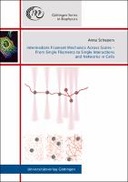Explore

Intermediate Filament Mechanics Across Scales – From Single Filaments to Single Interactions and Networks in Cells
0 Ungluers have
Faved this Work
Login to Fave
The mechanical properties of cells are largely determined by the cytoskeleton. The cytoskeleton is an intricate and complex structure formed by protein filaments, motor proteins, and crosslinkers. The three main types of protein filaments are microtubules, actin filaments, and intermediate filaments ( IFs ). Whereas the proteins that form microtubules and actin filaments are exceptionally conserved throughout cell types and organisms, the family of IFs is diverse. For example, the IF protein vimentin is expressed in relatively motile fibroblasts, and keratin IFs are found in epithelial cells. This variety of IF proteins might therefore be linked to the various mechanical properties of different cell types.
In the scope of this thesis, I combine studies of IF mechanics on different time scales and in systems of increasing complexity, from single filaments to networks in cells. This multiscale approach allows for the simplification necessary to interpret observations while adding increasing physiological context in subsequent experiments. We especially focus on the tunability of the IF mechanics by environmental cues in these increasingly complex systems. In a series of experiments, including single filament elongation studies, single filament stretching measurements with optical tweezers, filament-filament interaction measurements with four optical tweezers, microrheology, and isotropic cell stretching, we characterize how electrostatic (pH and ion concentration) and hydrophobic interactions (detergent) provide various mechanisms by which the mechanics of the IF cytoskeleton can be tuned. These studies reveal how small changes, such as charge shifts, influence IF mechanics on multiple scales. In combination with simulations, we determine the mechanisms by which charge shifts alter single vimentin filament mechanics and we extract energy landscapes for interactions between single filaments. Such insights will provide a deeper understanding of the mechanisms by which cells can maintain their integrity and adapt to the mechanical requirements set by their environment.
This book is included in DOAB.
Why read this book? Have your say.
You must be logged in to comment.
Editions

